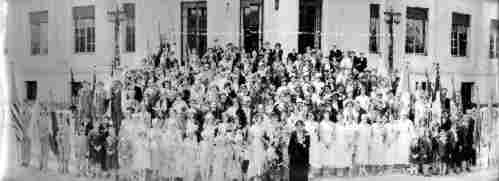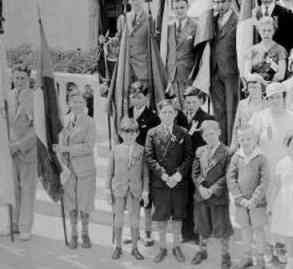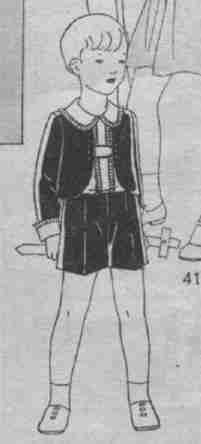
Figure 1.--Group shots in the early 1930s often show the younger boys in short pants suits, older elementary and younger highschool boys in knicker suits, and older highschool boys in long pants suits. This photograph was taken in 1933.

American boys in the 1930s wore suits with short pants, knickers, and long pants. Short pants suits were mostly worn by younger boys, although some older boys, especially boys from afluent families were more likely to wear them. Most American boys wore knicker suits, although not as commonly as in the 1920s. Most older boys had long pants suits. Outwardly American men's clothing had changed only subtly during 1930s. Men and older boys wore suits with wider shoulders and more double-breasted suits. Boys wore both single and double breasted suits. School age boys mostly wore knicker suits in the early-30s, as in the 1920s. They were no longer universal, bit still widely worn. Some yunger boys might wear short pants suits, but by the time they were 8 or 9, sometimes earlier, they wanted knickers or even long pants. Many men of the era can remember to this day when they got their first pair of knickers and then long pants. This chnged substantiakky by the end of the dedcde. We see fewer kncker suits and far more long pants suits. And unlike the early-30s, boys began wearing knickers with ankle socks, especially during the summer months.

Figure 2.--This enlargement of the above 1933 photograph shows the younger boys wearing short pants suits and the older boys knicker suits. Notice the one boy wearing the open collar style. |
Notiable shifts occurred during the 1930s in the suits worn by American boys. Throughout the decade there were boys wearing short pants, knickers, and long pants suits. Short pants suits continued to be worn by mostly younger or although boys. Most American boys wore knicker suits. A the beginning of the decade most all school-age boys wore knicker suits. The younger elementary boys, especially from affluent families might wear short pants suits. The older high school boys wore longs. By the end of the decade almost all high school boys had long pants suits as well as some grade school boys.
Outwardly American men's clothing had changed only subtly during 1930s. Men and older boys wore suits with wider shoulders and more double-breasted suits. Boys wore both single and double breasted suits. School age boys mostly wore knicker suits. All knickers by the 1930s buckled below the knee. Younger boys might wear short pants suits, but by the time they were 8 or 9, sometimes earlier, they wanted knickers or even long pants. Many men of the era can remember to this day when they got their first pair of knickers and then long pants. Some boys began wearing open collar shirts with their suits. These shirts had large collars and were made to be worn without ties. This was primarily a style for grade-school boys.
|
Kneesocks were not nearly as common in america as in Europe. Many American boys wore their short pants suits with ankle socks. This was especially true of younger boys and became more so toward the end of the decade. Knicker suits were mostly worn with keesovks, although boys often wore their knickers with ankle socks during the winter.
Argyle and other patterned kneesocks were commonly worn. Solid colored kneesocks were less popular in Anmerican than in Europe.
Very apparent age differences were observable during the 1930s. It was mostly the younger boys who wore short pants suits. Most school-age boys wore knicker suits and highschool boys wore longpants suits. There were some variations depnding on the year, season, region, and social class.
The style of suit varied somewhat by region. Short pants suits were more common in the South, especially during the summer when in the pre-airconditioned era, the weather could be stifling.
Social class was also a factor. Many boys, especially school-age boys, friom wealthy families were much more likely to wear short pants suits. This was in part because wealthy families were more influebced by European styles, especially British styles.

Figure 3.--Younger wealthy boys in the 1930s still wore fancy velvet party suits with short pants. The advertisement with this drawing indicated that it was for size 6-10. |
Navigate the Historic Boys' Clothing Web Site:
[Return to the Main 1930s page]
[Return to the Main U.S. page]
[Return to the Main U.S. Inter-War page]
[U.S. 1900s page]
[U.S. 1910s page]
[U.S. 1920s page]
[U.S. 1930s page]
[U.S. 1940s page]
[U.S. 1950s page]
[U.S. 1960s page]
[U.S. 1970s page]
[U.S. 1980s page]
[U.S. 1990s page]
Navigate the Historic Boys' Clothing Web Site:
[Introduction]
[Chronologies]
[Style Index]
[Biographies]
[Bibliographies]
[Contributions]
[Activities]
[Countries]
[Boys' Clothing Home]
Navigate the Historic Boys' Clothing Web chronological pages:
[The 1800s]
[The 1840s]
[The 1880s]
[The 1900s]
[The 1910s]
[The 1920s]
[The 1930s]
[The 1940s]
[The 1950s]
[The 1960s]
[The 1970s]
[The 1980s]
